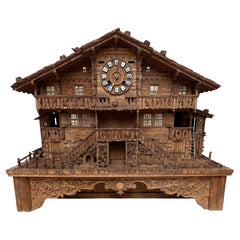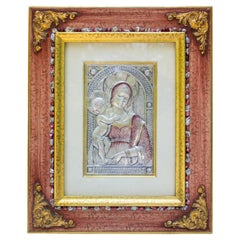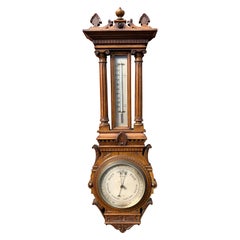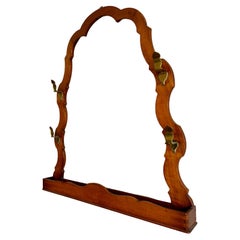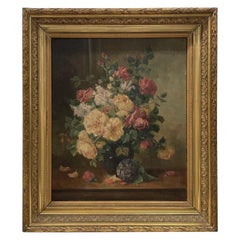Hand-Carved Decorative Art
Late 19th Century Swiss Black Forest Antique Hand-Carved Decorative Art
Enamel, Brass, Iron
20th Century Italian Rococo Hand-Carved Decorative Art
Gold Leaf, Silver
2010s American Organic Modern Hand-Carved Decorative Art
Ceramic, Stoneware
Early 20th Century English Victorian Hand-Carved Decorative Art
Brass
Late 19th Century European Victorian Antique Hand-Carved Decorative Art
Brass
Late 19th Century French Antique Hand-Carved Decorative Art
Canvas, Giltwood
Early 20th Century European Arts and Crafts Hand-Carved Decorative Art
Metal, Brass
Mid-20th Century Italian Art Deco Hand-Carved Decorative Art
Alabaster, Metal
Late 19th Century French Napoleon III Antique Hand-Carved Decorative Art
Metal
18th Century Italian Rococo Antique Hand-Carved Decorative Art
Gold Leaf
Mid-20th Century Italian Mid-Century Modern Hand-Carved Decorative Art
Metal, Brass
20th Century Spanish Neoclassical Revival Hand-Carved Decorative Art
Walnut
1950s German Arts and Crafts Vintage Hand-Carved Decorative Art
Metal
Mid-19th Century French Gothic Antique Hand-Carved Decorative Art
Glass, Wood, Paper, Oak, Ash
20th Century Spanish Mid-Century Modern Hand-Carved Decorative Art
Wood
Late 18th Century Italian Rococo Antique Hand-Carved Decorative Art
Oak
Late 19th Century Italian Baroque Antique Hand-Carved Decorative Art
Canvas, Giltwood
Early 1900s Italian Baroque Antique Hand-Carved Decorative Art
Canvas, Giltwood
18th Century Swedish Gustavian Antique Hand-Carved Decorative Art
Pine
17th Century French Baroque Antique Hand-Carved Decorative Art
Canvas, Giltwood
1910s Italian Baroque Vintage Hand-Carved Decorative Art
Canvas, Giltwood
19th Century Indian Moorish Antique Hand-Carved Decorative Art
Brass
Late 19th Century Congolese Primitive Antique Hand-Carved Decorative Art
Wood
Early 1900s French Belle Époque Antique Hand-Carved Decorative Art
Glass, Giltwood, Paper
20th Century Unknown Primitive Hand-Carved Decorative Art
Wood
Late 19th Century Austrian Belle Époque Antique Hand-Carved Decorative Art
Canvas, Giltwood
Early 1900s Italian Baroque Antique Hand-Carved Decorative Art
Canvas, Giltwood
Late 19th Century Swiss Black Forest Antique Hand-Carved Decorative Art
Wood
19th Century Italian Antique Hand-Carved Decorative Art
Wood
Mid-19th Century Indian Anglo-Indian Antique Hand-Carved Decorative Art
Silk, Blown Glass, Ebony
18th Century and Earlier Italian Renaissance Antique Hand-Carved Decorative Art
Gold Leaf
Late 19th Century Papua New Guinean Primitive Antique Hand-Carved Decorative Art
Wood, Paint
18th Century French Louis XVI Antique Hand-Carved Decorative Art
Wood
21st Century and Contemporary Indian Hand-Carved Decorative Art
Marble
Mid-18th Century French French Provincial Antique Hand-Carved Decorative Art
Brass, Bronze
1890s Tibetan Tibetan Antique Hand-Carved Decorative Art
Wood
Early 20th Century Burmese Art Deco Hand-Carved Decorative Art
Wood, Giltwood
Late 18th Century Italian Rococo Antique Hand-Carved Decorative Art
Walnut
Mid-20th Century Swedish Mid-Century Modern Hand-Carved Decorative Art
Ceramic, Pottery, Stoneware
Mid-20th Century Danish Scandinavian Modern Hand-Carved Decorative Art
Ceramic, Stoneware, Pottery
17th Century Italian Baroque Antique Hand-Carved Decorative Art
Canvas, Giltwood
19th Century Italian Renaissance Antique Hand-Carved Decorative Art
Wood, Paint
Mid-20th Century French Organic Modern Hand-Carved Decorative Art
Wood, Pine
19th Century French Louis XVI Antique Hand-Carved Decorative Art
Glass, Giltwood
18th Century Italian Rococo Antique Hand-Carved Decorative Art
Rock Crystal, Gold Leaf
1880s French Black Forest Antique Hand-Carved Decorative Art
Wood
19th Century Italian Baroque Antique Hand-Carved Decorative Art
Gesso, Canvas, Wood
Late 18th Century French Louis XVI Antique Hand-Carved Decorative Art
Giltwood
1870s French Rococo Antique Hand-Carved Decorative Art
Porcelain, Wood
1930s German Folk Art Vintage Hand-Carved Decorative Art
Wood
Mid-20th Century European Art Deco Hand-Carved Decorative Art
Alabaster, Iron
19th Century French French Provincial Antique Hand-Carved Decorative Art
Pine
17th Century Peruvian Antique Hand-Carved Decorative Art
Wood, Paint, Giltwood
18th Century Italian Baroque Antique Hand-Carved Decorative Art
Gold Leaf
Early 20th Century German Black Forest Hand-Carved Decorative Art
Oak
Mid-20th Century Chinese Chinese Export Hand-Carved Decorative Art
Wood
Mid-20th Century French Art Deco Hand-Carved Decorative Art
Canvas, Wood
Early 20th Century German Greco Roman Hand-Carved Decorative Art
Canvas, Giltwood
Early 20th Century German Black Forest Hand-Carved Decorative Art
Walnut
1850s French French Provincial Antique Hand-Carved Decorative Art
Mother-of-Pearl
Read More
At Colonial Williamsburg, Everything Old Is New Again
With the help of a new director, the Virginia institution's folk art and decorative arts museums are undergoing extensive upgrades.
New York’s Hirschl & Adler Showcases the American Workmanship and Design Panache of Neoclassical Treasures
The gallery's latest exhibition proves that museum-quality pieces entice and inspire, whether in traditional or more modern interiors.
